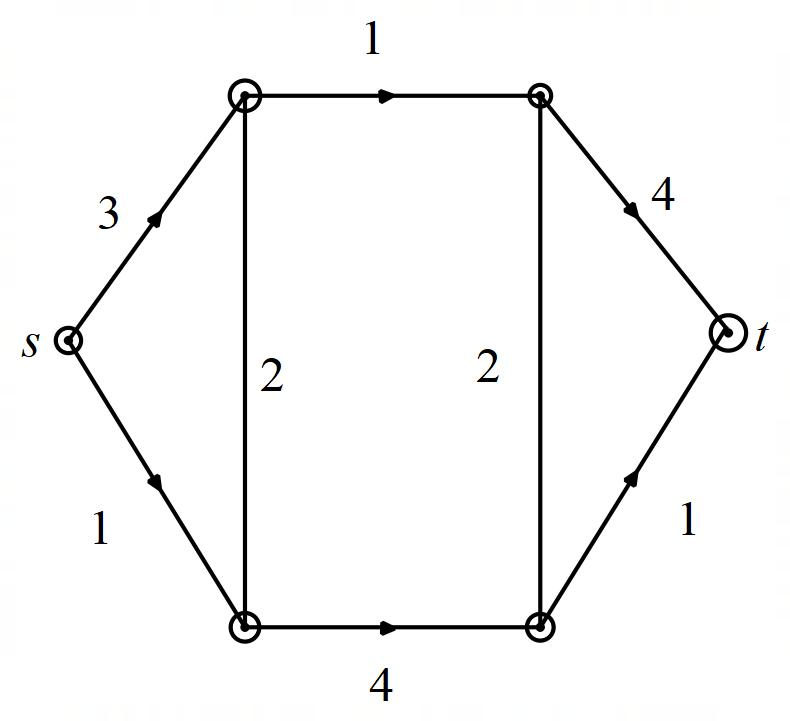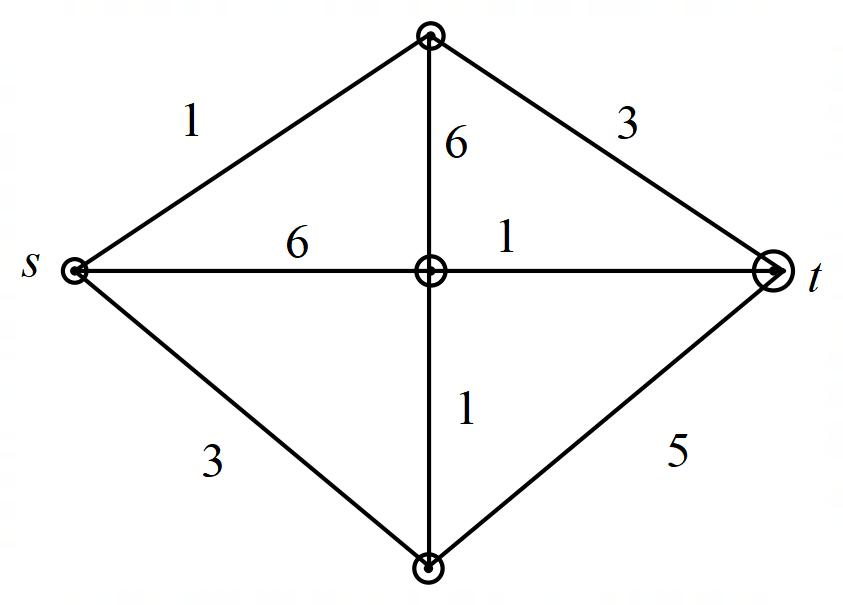
Discrete Mathematics with Graph Theory (Classic Version) (3rd Edition) (Pearson Modern Classics for Advanced Mathematics Series)
3rd Edition
ISBN: 9780134689555
Author: Edgar Goodaire, Michael Parmenter
Publisher: PEARSON
expand_more
expand_more
format_list_bulleted
Question
Chapter 14.3, Problem 5E
(a)
To determine
A maximum flow for each of the following network (Note that some edges are undirected.)

(b)
To determine
A maximum flow for each of the following network (Note that some edges are undirected.)

Expert Solution & Answer
Want to see the full answer?
Check out a sample textbook solution
Students have asked these similar questions
High Cholesterol: A group of eight individuals with high cholesterol levels were given a new drug that was designed to lower cholesterol levels. Cholesterol levels, in milligrams per deciliter, were measured before and after treatment for each individual, with the following results:
Individual Before
1
2
3
4
5
6
7
8
237
282
278
297
243
228
298
269
After
200
208
178
212
174
201
189
185
Part: 0/2
Part 1 of 2
(a) Construct a 99.9% confidence interval for the mean reduction in cholesterol level. Let a represent the cholesterol level before treatment minus the cholesterol level after. Use tables to find the critical value and round the answers to at least one decimal place.
Please could you explain how to do integration by parts for this question in detail please
There were 426 books sold in one week. The number of biology books sold was 5 times that of the number of psychology books. How many books each were sold?
Chapter 14 Solutions
Discrete Mathematics with Graph Theory (Classic Version) (3rd Edition) (Pearson Modern Classics for Advanced Mathematics Series)
Ch. 14.1 - 1. This directed network illustrates a valid -...Ch. 14.1 - Prob. 2TFQCh. 14.1 - Prob. 3TFQCh. 14.1 - Prob. 4TFQCh. 14.1 - Prob. 5TFQCh. 14.1 - Prob. 6TFQCh. 14.1 - Prob. 7TFQCh. 14.1 - Prob. 8TFQCh. 14.1 - Prob. 9TFQCh. 14.1 - Prob. 10TFQ
Ch. 14.1 - Prob. 1ECh. 14.1 - Prob. 2ECh. 14.1 - Prob. 3ECh. 14.1 - Prob. 4ECh. 14.1 - Answer the following questions for each of the...Ch. 14.1 - Prob. 6ECh. 14.1 - Prob. 7ECh. 14.2 - The chain scabt in this network is...Ch. 14.2 - Prob. 2TFQCh. 14.2 - Prob. 3TFQCh. 14.2 - Prob. 4TFQCh. 14.2 - Prob. 5TFQCh. 14.2 - Prob. 6TFQCh. 14.2 - Prob. 7TFQCh. 14.2 - Prob. 8TFQCh. 14.2 - Prob. 9TFQCh. 14.2 - Prob. 10TFQCh. 14.2 - Answer the following two questions for each of the...Ch. 14.2 - 2. Find a maximum flow for each of the networks in...Ch. 14.2 - Prob. 3ECh. 14.2 - Shown are two networks whose arc capacities are...Ch. 14.3 - 1. To solve a maximum flow problem where are...Ch. 14.3 - Prob. 2TFQCh. 14.3 - Prob. 3TFQCh. 14.3 - Prob. 4TFQCh. 14.3 - Prob. 5TFQCh. 14.3 - Prob. 6TFQCh. 14.3 - Prob. 7TFQCh. 14.3 - Prob. 8TFQCh. 14.3 - If T is a tree, there is a unique path between any...Ch. 14.3 - Prob. 10TFQCh. 14.3 - Prob. 1ECh. 14.3 - Prob. 2ECh. 14.3 - 3. Four warehouses, A,B,C and D. with monthly...Ch. 14.3 - 4. Answer Question 3 again, this time assuming...Ch. 14.3 - Prob. 5ECh. 14.3 - Verify Mengers Theorem, Theorem 14.3.1 for the...Ch. 14.3 - Prob. 7ECh. 14.3 - Prob. 8ECh. 14.3 - Prob. 9ECh. 14.3 - Prob. 10ECh. 14.4 - 1. A graph with 35 vertices cannot have a perfect...Ch. 14.4 - 2. The graph has a perfect matching.
Ch. 14.4 - Prob. 3TFQCh. 14.4 - Prob. 4TFQCh. 14.4 - Prob. 5TFQCh. 14.4 - Prob. 6TFQCh. 14.4 - Prob. 7TFQCh. 14.4 - Prob. 8TFQCh. 14.4 - Prob. 9TFQCh. 14.4 - 10. Hall’s marriage Theorem is named after the...Ch. 14.4 - Prob. 1ECh. 14.4 - :Repeat Exercise 1 with reference to the following...Ch. 14.4 - 3. Determine whether the graph has perfect...Ch. 14.4 - 4. Angela, Brenda, Christine, Helen, Margaret,...Ch. 14.4 - Prob. 5ECh. 14.4 - Bruce, Edgar, Eric, Herb, Maurice, Michael,...Ch. 14.4 - Prob. 7ECh. 14.4 - Prob. 8ECh. 14.4 - Suppose v1,v2 are the bipartition sets in a...Ch. 14.4 - Prob. 10ECh. 14.4 - Prob. 11ECh. 14.4 - Prob. 12ECh. 14.4 - Prob. 13ECh. 14.4 - Prob. 14ECh. 14.4 - Prob. 15ECh. 14.4 - Prob. 16ECh. 14 - Prob. 1RECh. 14 - Prob. 2RECh. 14 - Prob. 3RECh. 14 - Prob. 4RECh. 14 - Prob. 5RECh. 14 - 6.For each network, find a maximum flow and...Ch. 14 - 7.(a) Which graph have the property that for any...Ch. 14 - Prob. 8RECh. 14 - Prob. 9RECh. 14 - Prob. 10RECh. 14 - Prob. 11RE
Knowledge Booster
Learn more about
Need a deep-dive on the concept behind this application? Look no further. Learn more about this topic, subject and related others by exploring similar questions and additional content below.Similar questions
- I worked out the answers for most of this, and provided the answers in the tables that follow. But for the total cost table, I need help working out the values for 10%, 11%, and 12%. A pharmaceutical company produces the drug NasaMist from four chemicals. Today, the company must produce 1000 pounds of the drug. The three active ingredients in NasaMist are A, B, and C. By weight, at least 8% of NasaMist must consist of A, at least 4% of B, and at least 2% of C. The cost per pound of each chemical and the amount of each active ingredient in one pound of each chemical are given in the data at the bottom. It is necessary that at least 100 pounds of chemical 2 and at least 450 pounds of chemical 3 be used. a. Determine the cheapest way of producing today’s batch of NasaMist. If needed, round your answers to one decimal digit. Production plan Weight (lbs) Chemical 1 257.1 Chemical 2 100 Chemical 3 450 Chemical 4 192.9 b. Use SolverTable to see how much the percentage of…arrow_forwardPopulation decreases 5% each year. Starts with a starting population of 3705. Find that population after 5 years.arrow_forwardsolve using substitution -2x-3y=-15 -3x+9y=12arrow_forward
- Suppose that 7000 is placed in an accout that pays 4% interest. Interest compunds each year. Assume that no withdraws are made. How much would the account have after 1 year? And how much would the account have after 2 years?arrow_forwardUse substitution to solve the equations -2x+5y=18 x=2y-8arrow_forwardAt the beginning of year 1, you have $10,000. Investments A and B are available; their cash flows per dollars invested are shown in the table below. Assume that any money not invested in A or B earns interest at an annual rate of 2%. a. What is the maximized amount of cash on hand at the beginning of year 4.$ ___________ A B Time 0 -$1.00 $0.00 Time 1 $0.20 -$1.00 Time 2 $1.50 $0.00 Time 3 $0.00 $1.90arrow_forward
- 7. The demand for a product, in dollars, is p = D(x) = 1000 -0.5 -0.0002x² 1 Find the consumer surplus when the sales level is 200. [Hints: Let pm be the market price when xm units of product are sold. Then the consumer surplus can be calculated by foam (D(x) — pm) dx]arrow_forward2. Claim events on a portfolio of insurance policies follow a Poisson process with parameter A. Individual claim amounts follow a distribution X with density: f(x)=0.0122re001, g>0. The insurance company calculates premiums using a premium loading of 45%. (a) Derive the moment generating function Mx(t).arrow_forward4. Find the general solution and the definite solution for the following differential equations: (a) +10y=15, y(0) = 0; (b) 2 + 4y = 6, y(0) =arrow_forward
- 5) For each function represented by an equation, make a table and plot the corresponding points to sketch the graph of the function. (a) y = 75 ()* 220 X y 200- -2 180 160 -1 140 0 120 100 1 60 80 2 3 4 x (b) y = 20 ()* 1 60 40 20 20 0 2 3 65- -1 X y 60 -2 55- 50 45 44 40 0 35- 30 1 25 2 20 20 15 3 10 5 LO 4 3-2 T -1 0 5- 4- -3- 2-arrow_forward5. Find the solution to each of the following by using an appropriate formula developed in the lecture slides: (a) + 3y = 2, y(0) = 4; (b) dy - 7y = 7, y(0) = 7; (c) 3d+6y= 5, y(0) = 0arrow_forward1. Evaluate the following improper integrals: (a) fe-rt dt; (b) fert dt; (c) fi da dxarrow_forward
arrow_back_ios
SEE MORE QUESTIONS
arrow_forward_ios
Recommended textbooks for you
 Glencoe Algebra 1, Student Edition, 9780079039897...AlgebraISBN:9780079039897Author:CarterPublisher:McGraw Hill
Glencoe Algebra 1, Student Edition, 9780079039897...AlgebraISBN:9780079039897Author:CarterPublisher:McGraw Hill

Glencoe Algebra 1, Student Edition, 9780079039897...
Algebra
ISBN:9780079039897
Author:Carter
Publisher:McGraw Hill
Minimum cuts and maximum flow rate; Author: Juddy Productions;https://www.youtube.com/watch?v=ylxhl1ipWss;License: Standard YouTube License, CC-BY